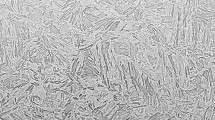Abstract
A generalized framework has been developed within ABAQUS to model the surface hardening heat treatment processes for automotive steel components. The macro-scale heat transfer and stress calculations during the heating and quenching are coupled with the microstructural phase calculations, defined through a user routine, to estimate key process parameters such as case depth and surface hardness. This model has been applied to predict these parameters in two key industrial processes, i.e., case hardening of crankshafts and case carburization of gears. The results of the case depth and hardness calculations have been validated with the literature and in-house plant data. The effect of varying quench conditions on the overall stress distribution changes within the component has been outlined.






















Similar content being viewed by others
References
M.A. Grossmann, E.C. Bain (1964) Principles of Heat Treatment. American Society for Metals, Cleveland, OH.
M. Chatterjee: Industrial Gears, 2003, http://www.inductoheat.com/.
B.L. Ferguson, Z. Li and A.M. Freborg: “Modeling Heat Treatment of Steel Parts”, Computational Material Science, 2005, vol. 34 (3), pp. 274-281.
H.J. Grabke and I. Wolf: “Carburization and Oxidation”, Material Science and Engineering, 1985, vol. 87, pp. 838-844.
A. Candeo, C. Ducassy, P. Bocher, F. Dughiero (2011) IEEE Trans. Magn. 47:918-921.
D.G. Fugarolas: Modeling Induction Hardening—A Detailed Example of Modeling Techniques Applied to the Materials Science Aspects of a Manufacturing Process, Vdm Verlag Publication, 2008, ISBN-13:978-3-639-06296-0.
N. Barka, P. Bocher, J. Brousseau, M. Galopin, and S. Sundararajan: “Modeling and Sensitivity Study of the Induction Hardening Process”, Advanced Materials Research, 2007, vols. 15-17, pp. 525-530.
Y. Toi and M. Takagaki: Proceedings of the World Congress on Engineering and Computer Science, S.I. Ao, C. Douglas, W.S. Grundfest, L. Schruben, and J. Burgstone, eds., 2008, ISBN: 978-988-98671-0-2, pp. 196–200.
J.I. Goldstein and A.E. Moren: “Diffusion Modeling of the Carburization Process”, Metall. Trans. A, 1978, vol. 9A (11), pp. 1515-1525.
A. Engstrom, L. Höglund and J. Agren: “Computer Simulation of Diffusion in Multiphase Systems”, Metall. Mater. Trans. A, 1994, vol. 25A (6), pp. 1125-1134.
P.K. Agarwal and J.K. Brimacombe: “Mathematical Model of Heat Flow and Austenite-Pearlite Transformation in Eutectoid Carbon Steel Rods for Wire”, Metall. Trans. A, 1981, vol. 12B, pp. 121-133.
D.P. Koistinen and R.E. Marburger: “A General Equation for Austenite –. Martensite Transformation in Pure Carbon Steels”, Acta Met., 1959, vol. 7, pp. 59-60.
ABAQUS Online Documentation: Version 6.11, Dassault Systemes, 2011, http://abaqus.ethz.ch:2080/v6.11.
C. H. Gur, J. Pan (2008) Handbook of Thermal Process Modeling of Steels. Taylor & Francis Group, Boca Raton.
P.R. Woodard, S. Chandrasekar, and H.T.Y. Yang: “Analysis of Temperature and Microstructure in the Quenching of Steel Cylinders”, Metall. Mater. Trans., 1999, vol. 30B, pp. 815-822.
F.M.B. Fernandes, S. Denis, and A. Simon: “Mathematical Model Coupling Phase Transformation and Temperature Evolution during Quenching of Steels”, Material Science and Technology, 1985, vol. 1, pp. 838-844.
K. Thelning (1984) Steel and Its Heat Treatment, 2nd edn, Butterworth-Heinemann, London
Acknowledgments
We gratefully acknowledge the support by Mahesh Karandikar, GM India, for providing process data and material properties pertaining to the Induction Hardening and Ganesan SP and his GM transmission team for providing data pertaining to the gear carburization process.
Author information
Authors and Affiliations
Corresponding author
Additional information
Manuscript submitted January 26, 2012.
Rights and permissions
About this article
Cite this article
Munikamal, T., Sundarraj, S. Modeling the Case Hardening of Automotive Components. Metall Mater Trans B 44, 436–446 (2013). https://doi.org/10.1007/s11663-012-9775-7
Published:
Issue Date:
DOI: https://doi.org/10.1007/s11663-012-9775-7




